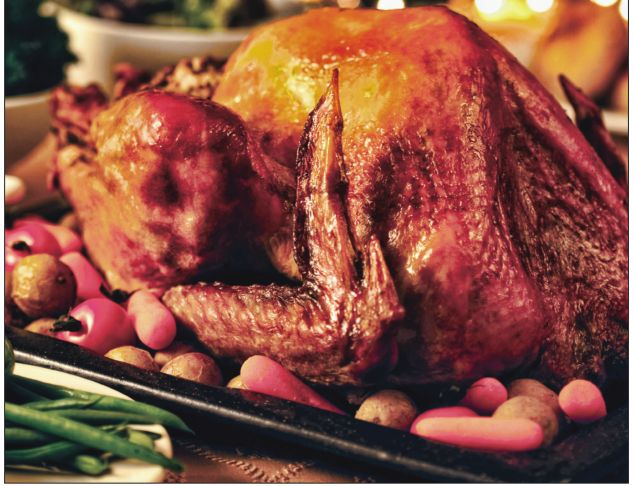
Where there’s smoke!
Oven? Not this year. Follow two of the most popular turkey trends to the great outdoors: grilling and smoking
HOLIDAY FOOD | Matthew M. F. Miller
Breaking with tradition is always a test of the home cook’s mettle, especially around the holidays. Loved ones have expectations and when they aren’t met, disappointment causes upset even Tums can’t relieve. For those looking to make the leap from the oven to the outdoors this year, there are a few general guidelines to make sure that the holiday turkey turns out well done – and not charred or dry.
The USDA Food Safety and Inspection Service recommends the following pointers for successfully smoking a turkey:
Whole turkeys that weigh 12 pounds or less are the recommended size for safe grilling or smoking. A larger turkey remains in the “danger zone” – between 40 degrees F and 140 degrees F – too long. If a larger turkey has been mistakenly purchased, detach the dark meat sections (leg and thigh portions) from the breast and smoke/grill the turkey parts separately. This procedure should result in the best possible results.
When purchasing a whole turkey or turkey breast, the structure is as important as the weight. Generally, a turkey that is broad and flat will fit better under the covered smoker or grill than one that protrudes too high in the breast area. Remember there should be at least one inch of space between the turkey and the lid.
Do not stuff the smoked turkey. Because smoking is at a low temperature, it can take too long for the temperature of the stuffing to reach the required temperature of 165 degrees F. Also, smoked stuffing has an undesirable flavor.
Following is a recipe for a grilled turkey and one for a smoked turkey, courtesy the National Turkey Federation.
Savory grilled turkey
Delight holiday guests’ taste buds with a new take on the holiday bird.
The savory and rich flavor profile the grill adds to the turkey will keep your recipe in the books for seasons to come.
• 1 (12-pound) whole turkey
• 1 cup unsalted butter, cubed
• 1/2 cup cider vinegar
• 1/2 cup freshly squeezed lemon juice
• 1 tablespoon Worcestershire sauce
• 1 tablespoon A-1 steak sauce
• 1 teaspoon kosher salt
• 1 teaspoon freshly ground black pepper
• 1 teaspoon Louisiana-style hot sauce Remove giblets from turkey (discard or save for another use).
Using long-handled tongs, moisten a paper towel with cooking oil and lightly coat the grill rack. Prepare grill for indirect heat, using a drip pan in the center. Skewer turkey openings closed.
When the grill temperature has reached about 350° F, place turkey on the grill rack, directly over the drip pan. Grill, covered, over indirect medium heat for 1 hour.
Meanwhile, in a small saucepan, combine the remaining ingredients. Bring to a boil. Reduce heat; simmer for 10 minutes, stirring occasionally. Remove from the heat. Set aside and cover 2/3 cup for serving.
Continue to grill turkey 1 to 2 hours longer or until a meat thermometer reads 175 degrees F in the thigh, basting frequently with remaining sauce.
Cover turkey and let stand for 15 minutes before carving. Serve with reserved sauce.
Smoked turkey
When using a charcoal smoker, fill the liquid pan with water, wine, apple juice or the liquid you desire.
Fill
the charcoal pan with a good quality charcoal. Light the charcoal and
place the cover on the smoker. When the smoker has reached an internal
temperature of 250 degrees F to 300 degrees F, quickly place the turkey
on the smoker rack and replace the cover. (Some smokers have built-in
temperature indicators. If not, place an appliance thermometer on the
smoker rack before starting the heat.)
Add
charcoal every hour, as necessary, to maintain 250 degrees F to 300
degrees F. Replenish the liquid as necessary. Heat and liquid are
critical to maintaining the hot smoke that cooks the turkey.
When
cooking with a smoker, start with clean equipment. Place the smoker in
an area shielded from winds to maintain a consistent cooking
temperature. To enhance the flavors, add chunks or chips of water-soaked
hardwood or fruitwood. DO NOT use softwood (pine, fir, cedar or spruce)
as it gives the food a turpentine flavor and coats it with a black
pitch or resin.
Smoking time depends on many factors:
the
size and shape of the turkey, the distance from the heat, temperature
of the coals and the outside air temperature. Estimate 20 to 30 minutes
per pound if using a smoker. Always use a food thermometer. The whole
turkey is done when the food thermometer, placed in the inner thigh,
reaches 180 degrees F. The breast is done when the internal temperature
reaches 170 degrees F.